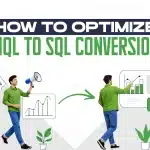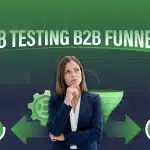Predictive lead scoring helps decide which lead has more potential to convert as a paid customer, like choosing your prince charming without kissing the head of every frog in the pond. Suppose you have two leads, lead X and lead Y, which one will you pick? Without scoring, it’s really tough. So in this article, we will walk you through the answer to the question with every single detail of predictive lead scoring.
What Is Predictive Lead Scoring?
Predictive lead scoring is a method of scoring leads based on historical and previous activity-related data to predict that respective leads are most likely to convert into a paid customer. Predictive lead scoring uses artificial intelligence (AI) and machine learning to analyse past data of a prospect to determine the possibility of conversion. Different scoring models have their unique ways of working. The two main types:
- point-based lead scoring
- predictive lead scoring
Each of these lead scoring has its own aura. But depending on the digitisation, predictive lead scoring is spreading faster and is more available at a low cost. But choose which fits your business the best.
How Predictive Lead Scoring Works
Instead of assigning a manual score on email opens, clicks, ICP, location, industry, company size, etc, predictive lead scoring utilises data and machine learning to predict the lead’s conversion probability. Let’s take a look at the key points of predictive lead scoring working flow in the points below, which enlighten your lead generation process.

Data Sources
Predictive lead scoring relies on a wide range of data about a prospect to provide a prediction for conversion.
- Behavioural data: website visit, webinar attendance, content downloads, email engagement
- Demographic data: job title, role, industry, company size, location
- Firmographic data: Revenue, number of employees, growth rate.
- Historical CRM data: Lead outcome, past conversions, sales interactions.
Feature Engineering
Feature engineering converts raw data into meaningful variables that machine learning can use for further processing.
- Combine multiple methods to create predictive features (click rate, email opens).
- Normalise or scale data to ensure consistency.
- Encode categorical variables like industry or region into numerical formats suitable for modelling.
Model Options
Several machine learning models can be applied to score leads depending on the complexity of your lead and data.
- Logistic Regression: Simple, interpretable, and effective for smaller datasets.
- Decision Trees & Random Forests: Decision Trees & Random Forests handle nonlinear relationships and complex interactions.
- Gradient Boosting Models: High accuracy for large datasets (XGBoost, LightGBM).
- Neural Networks: This model is suitable for very large datasets with complex patterns.
Training & Validation
The model is trained on historical data where the converted and unconverted data are recognised:
- Split data into training and validation sets.
- Train the model on the training set and evaluate performance on the validation set.
- Use metrics like AUC-ROC, precision, recall, and F1-score to measure predictive accuracy.
Score Calibration & Thresholds
Once the lead scoring prediction model guesses conversion probabilities, the scores are measured for practical use:
- Normalise scores into a standard range (0 – 100).
- Define thresholds for lead prioritisation (hot, warm, cold leads).
- Integrate the scores into CRM systems to automate lead assignment and follow-up workflows.
Implementation Checklist (Step-By-Step)
Predictive lead scoring implementation is a crucial thing, so you need to check some key points that must be accurate; otherwise, your entire process can be meaningless.
- Define the success label and time window ( lead-to-opportunity within 60 days).
- Map all data sources (CRM, marketing automation, web analytics).
- Build a feature set (behavioural, demographic, firmographic, historical).
- Train a baseline model using historical data.
- Evaluate and calibrate results using validation metrics.
- Choose scoring thresholds aligned with sales priorities.
- Sync scores to CRM/marketing automation platform.
- Route leads and set alerts for sales teams.
- Run A/B tests vs. traditional scoring.
- Monitor performance, track model drift, and refresh regularly.
Data Requirements & Quality Standards
Predictive lead scoring works best when supported by quality data. Essential elements include
- Completeness: Avoid missing data like job title, company size, role, etc
- Accuracy: Validate CRM with real-world info
- Recency: Reduce old data and keep updating
- Consistency: Standardise formats with consistency
Evaluation Metrics And How To Make Decisions From Scores
When assessing predictive lead scoring model performance, you should keep track of:
- Precision: How many predicted hot leads actually convert?
- Recall: How many true converters were identified?
- F1-score: Balanced measure of precision and recall.
- AUC-ROC: Overall classification ability of the model.
Sales leaders can use these metrics to refine thresholds and decide where to focus.
Operationalising Scores In CRM And Marketing Automation
Once scores are available, the real value comes from automation. For example:
- High-scoring leads: Assigned to senior reps immediately.
- Medium-scoring leads: Nurtured via email workflows.
- Low-scoring leads: Placed into long-term drip campaigns.
This ensures sales teams focus on the most promising opportunities.
Governance, Privacy, And Compliance For Lead Scoring Models
When using predictive models, businesses must address:
- GDPR & CCPA compliance for personal data usage.
- Bias mitigation to prevent unfair scoring.
- Data governance frameworks to maintain accuracy and fairness.
B2B, B2C, And PLG: Scenario-Specific Considerations
PLG, B2C, and B2B sales leads with authentic data are crucial for predictive lead scoring. Let’s take a look details in a brief point below.
- B2B: Firmographic data (company size, revenue, industry) is crucial.
- B2C: Behavioural data (website browsing, app usage, purchase intent) dominates.
- PLG (Product-Led Growth): In-product signals (trial activity, feature usage) are key.
Common Pitfalls And How To Avoid Them
- Poor data quality: Leads to inaccurate scores. Solution: Invest in data hygiene.
- Overfitting models: Works on historical data but fails in real-time. Solution: Validate with unseen data.
- Lack of adoption: Sales reps ignore scores. Solution: Train teams and prove value with quick wins.
- One-time setup: Models get stale. Solution: Refresh models regularly.
Conclusion
Predictive lead scoring is an AI and machine learning-based lead qualification methodology. Using tools like Salesforce Einstein, HubSpot CRM, and platforms like Pecan and Clay can help you identify potential leads that have a higher possibility of converting into paid customers. Before going for predictive lead scoring and buying software for this method, analyse your business thoroughly and determine if it fits your business.
FAQ
How does predictive lead scoring differ from traditional lead scoring?
Predictive lead scoring uses AI and advanced data analysis technology to predict a score, while traditional lead scoring follows a manual scoring strategy.
What are the benefits of using predictive lead scoring?
Direct benefits of predictive lead scoring are sales and marketing efficiency.
What are the key components of a predictive lead scoring model?
Data collection, machine learning algorithm, predictive engine, automation of process, feedback, etc, are the key components of predictive lead scoring.
How can predictive analytics improve lead qualification?
Analysing prospects’ demographic, firmographic, past history, behavioural activities, and predictive lead scoring efficiently improves lead qualification.
Which machine learning algorithms are used in predictive lead scoring?
Random Forests, XGBoost, and Gradient Boosting Models, et, are used to build a predictive lead scoring model.
Can small businesses benefit from predictive lead scoring?
Yes, small to large, all kinds of businesses can benefit from predictive lead scoring.
How accurate is predictive lead scoring in B2B marketing?
Depends on the accuracy of raw data, but more likely to be more effective than traditional methods, and some businesses see 28% to 40% more quality and success.
What is an example of a predictive lead scoring strategy?
using AI and historical data to identify which leads are most likely to convert by analysing their specific behaviours, such as downloading a pricing guide, visiting a pricing page, or viewing competitor reviews.
What data sources are most valuable for predictive lead scoring?
The most valuable data sources for predictive lead scoring include behavioural data (website visits, email engagement, content downloads), demographic data (age, location), firmographic data (company size, industry), and historical purchase and interaction data from your CRM and marketing platform.
How do predictive lead scoring tools integrate with CRMs?
Predictive lead scoring tools integrate with CRMs by using APIs to sync data from the CRM to the scoring tool, which analyzes it using machine learning to generate a probability score.
What KPIs should you track with predictive lead scoring?
Key KPIs for predictive lead scoring include the lead-to-customer conversion rate, to measure overall success; lead velocity, to track how fast leads move through the sales funnel; lead quality metrics like the MQL to SQL conversion rate; and sales cycle duration, which shows if higher-scored leads close faster.
Are there any challenges or risks with predictive lead scoring?
Challenges with predictive lead scoring include insufficient or poor-quality data, the complexity and cost of setting up and maintaining the AI models, difficulty integrating data from disparate systems, the need for ongoing model maintenance and recalibration, and a lack of alignment and training between marketing and sales teams to effectively utilise the scoring system.
How long does it take to implement predictive lead scoring?
Implementing predictive lead scoring can take anywhere from a few months to over six months, with some case studies showing results in as little as 90 days, depending on factors like data complexity, integration needs, and the chosen approach.
How often should predictive scoring models be updated?
Predictive scoring models should be updated based on their business impact and changes in data, rather than solely on calendar dates.
What’s the ROI of using predictive lead scoring?
The ROI of predictive lead scoring is notable, evidenced by a 70% boost in lead generation ROI, a 30% decrease in sales cycle duration, and revenue growth of up to 77% from marketing efforts.





